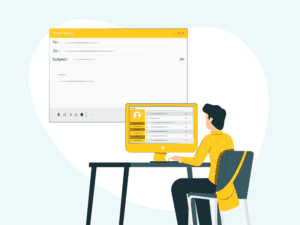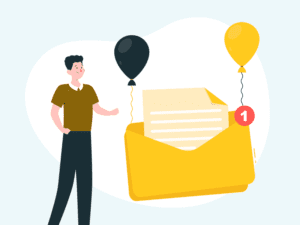As a business owner, you should always aim for a recurring revenue model. The benefits of this are simply undeniable.
It’s no surprise that 70% of business leaders claim subscription business models will be key to their future plans and the success they experience. They allow for better financial forecasting and long-term relationships which bring in higher revenue in the long run.
But every long, successful relationship needs to begin somewhere, and for you that’s the moment after the conversion. Of course, you’ll need to provide an incredible product that lives up to their expectations. Unfortunately, that alone isn’t enough in today’s environment.
We’ve spoken before about the importance of after-sales service in maximizing the experience your customers have. Now, we’re going to focus on those highly important first steps—the onboarding email sequence.
What are onboarding emails?

Automated customer onboarding emails are one of the most effective methods to deliver an excellent experience right off the bat. Once a customer buys a product or subscribes to a service, these emails will be sent out to guide them through the initial stages of interaction with the new product and your company.
Beyond showing a customer that they’re both welcome and appreciated, they serve as practical guides on how to use the product, encourage further engagement, and can even lead to cross-selling or upselling opportunities. Finally, they have the added benefit of either answering outstanding questions the new customer may have or getting feedback at key moments in the new relationship.
Establishing needs
Every business is different and it’s important to really map the customer’s experience at different points from when they first convert to three months into the relationship.
While we recommend planning for three months in, the majority of the communication should take place in the first week or two. After that, it’s more a matter of offering cross-selling or upselling opportunities at points when they may be experiencing particular needs or to find out feedback.
Before we begin outlining the specific emails, take a moment to think about what your customer needs are at different stages:
- Immediately after the sale:
- Do you need to provide access to any platform, tool, or similar?
- Do they need to provide you with any information to carry out your service?
- One day after the sale:
- What common pain points do your customers experience?
- What do they need to know to set everything up correctly?
- One week after the sale:
- What should they be able to do after one week that they couldn’t do the previous week?
- Two weeks after the sale:
- What common problems come up that you can address?
- Any cross-selling or up-selling opportunities?
If you aren’t sure, the best starting point is to consult your current customers. Remember we said how important feedback is? This is one of the areas where it comes in useful.
Reach out to your current customers and try to pinpoint issues or problems they experienced when they first signed up. You may be surprised with what you find!
Developing the automated customer onboarding email sequence

Once you have a fair idea of the common need-to-knows and challenges, you can begin developing the email sequence. The actual emails you decide to include is entirely up to you. Below, we’ll outline some of the different options you can take!
The welcome
Just like when someone signs up to your newsletter or lead magnet, every onboarding sequence should begin with a welcome email. It just gets everything off to the right start and sets the tone of positivity for what’s to come.
That’s not to say it should only be a welcome and contain nothing else. There are other pieces of information that you can include in that first email.
For example, if you need to provide them with access to any tools or platforms or get access to some of their assets, you can outline that here. It’s also a good idea to set out expectations, whether service expectations or giving them a heads up on the onboarding process that they’re going to be a part of.
What you shouldn’t use this email for is to upsell or cross-sell. This can easily come across as being too forward too quickly. Besides, there will be plenty of time for that later!
The explainer
You’ve welcomed your new client to the company and they have access to all necessary assets, etc. Now, it’s in your best interest to get the client using the product as quickly as possible. The sooner they’re able to see the value or the value that it will bring in the future, the better.
That’s why you send an explainer email! These emails (which can be a part of the welcome email if it makes sense!) should outline the basic aspect of the service and how it can help them.
The next steps

It’s very possible that the explainer email doesn’t offer enough value on its own. If that’s the case, you can either combine it with this email or just go straight to the next steps.
The next steps, as the name suggests, helps kick-start the training process. You can be as creative as you want here—as long as it’s extremely clear what the next steps are.
Depending on your product and your clients’ needs, you could send out a short two-three email series of these to stagger the onboarding and ensure they get exactly the guidance they need at the right time.
The community builder
You want to build trust and loyalty, right? Well, nothing does that better than the community builder. After all the essential first steps have been taken care of, you can invite your new customer to join any communities you might have.
Communities are one of the best ways to turn customers into true brand advocates and your business can benefit from it well into the future!
The cross and up-sellers
These emails are best sent at least a few weeks into the onboarding process. By now, your customers may well have noticed certain challenges or difficulties.
If this is the case, you should be able to provide them with complementary services to help them out. Take for example if you’re offering a subscription service and your new customer is on a lower tier. It may be that, by this stage, they’ve realized that their needs are more extensive than they originally anticipated. So, they may respond to an upselling email asking them to invest in the next tier.
The key is to always be upfront in your cross or upselling attempts. They are already customers so there’s no need to beat around the bush. Keep your emails light and attractive but also make sure to let them know that if they’re experiencing an ia specific issue, there are options available for them.
Feedback
One of the most important things you should be doing in your onboarding process is asking for feedback. Statistics show that only one in 26 unhappy customers actually provide feedback and most just silently leave. By proactively asking for feedback, you can get insights into issues before they become problems.
Firstly, you should let them know in the welcome email that they can always get in touch if they need anything. Think of it as an open invitation for feedback. But that’s not enough on its own.
As customers spend more time with your product, they’re going to be confronted with different issues and challenges along the way. You will be able to predict the times when they might need support, even if they don’t actively reach out.
Generally speaking, after the first two weeks, you should reach out to see how things are going. This is just about enough time for the initial honeymoon period to be over and they may be more critical than at the start. If you send out an email and they’re unhappy with something, it means you’re in a fantastic position to nip the issue in the bud and get things back on track.
These are the emails you should be sending for the longest time after the initial onboarding. Look at what makes sense for you, but as a guide, send one out after two weeks, a month and a week, and again after three months. This feedback is essential for ensuring a smooth ongoing relationship and for strengthening and refining your onboarding process.
The onboarding process is a delicate time in the customer relationship. The time you take to develop and refine it will pay dividends in terms of loyalty, retention, referrals and, of course, revenue.
If you’d like to find out more about how Pipeline.so can help you to maximize your onboarding potential, reach out to us today!

